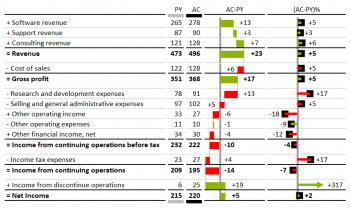Difference between revisions of "Template Tables"
(→Built in templates) |
|||
| Line 13: | Line 13: | ||
| IBCS Table 1 || IBCS Table 2 | | IBCS Table 1 || IBCS Table 2 | ||
|- | |- | ||
| − | | | + | | Compare Actuals to Plan and Previous year, for current month and YTD.|| Example |
|- | |- | ||
| [[Image:IBCSTable1.png|350px|centre]] || [[Image:IBCSTable2.png|350px|centre]] | | [[Image:IBCSTable1.png|350px|centre]] || [[Image:IBCSTable2.png|350px|centre]] | ||
Revision as of 11:15, 30 November 2020
Template tables allow you to easily add predefined tables that have usefuly metrics and formatting built into them. These can be used directly or further customised for your specific needs.
Contents
[hide]General features
The tables can be built on top of a cube or Pivot View which allows calculations to be built into the column definitions, and for users to drill down on the row members.
Columns can be formatted with standard number styles, or be displayed as in-cell charts for simple visualisation.
IBCS formatting can be applied to indicated data categories like Actual, Plan and Forecast.
Built in templates
| IBCS Table 1 | IBCS Table 2 |
| Compare Actuals to Plan and Previous year, for current month and YTD. | Example |
| IBCS Table 3 | IBCS Table 4 |
| Example | Example |
| IBCS Table 3 | IBCS Table 4 |
| Example | Example |



